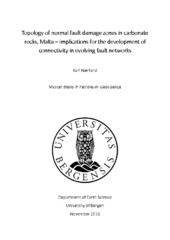Topology of normal fault damage zones in carbonate rocks, Malta - implications for the development of connectivity in evolving fault networks
Master thesis
Permanent lenke
https://hdl.handle.net/1956/15423Utgivelsesdato
2016-11-21Metadata
Vis full innførselSamlinger
- Department of Earth Science [1050]
Sammendrag
Fault damage zones are known to be more complex in linkage zones, relays and at fault tips. From a reservoir perspective, these damage complexities may act as conduits or barriers for fluid flow, hence they need to be understood and quantified. This study quantifies the fracture network properties of three different damage zone types: damage occurring around stage 2 to 4 relay ramps, splay faults and fault tips. Specifically, the connectivity is quantified by the use of topology. Topology uses fracture intersections and endpoints to quantify the relationships between fractures within a fracture network, by the use of nodes and branches. A topological approach is used on 18 damage zones in the study area, Ras ir Raheb, on the west coast of Malta. This area shows excellent outcrops of small-scale (throw less than 1m) normal faults formed in carbonate rocks. Analysis of the topology and geometry of the studied damage zones show that: the connectivity is lower in stage 2 relay damage zones and fault tips compared to stage 3 relay damage zones and splay fault damage zones. The greatest connectivity is documented in stage 4 relay damage zones, which indicates that connectivity develops with maturity. Circular sub-samples, fracture intensity- and connecting node frequency maps are used to analyse spatial variability within the damage zones. Results show that the higher values are localised in areas of bifurcation and linkage. The topological characteristics of studied damage zones may be used as proxies for different stages of fault and damage zone evolution, with fault tips representing an early stage, and hard-linked relays and splays representing further progressed stages of growth and linkage. Using this as a basis, a model for the development of connectivity in evolving extensional fault networks is presented: 1) fault initiation stage; multiple isolated faults are active, resulting in numerous fault tip damage zones. The fault network is immature at this stage, hence a low connectivity. 2) Interaction and linkage stage; faults start to interact and link, ergo the fault network becomes more connected and show a medium connectivity. 3) Through-going fault zones; deformation continues and becomes localised along a few through-going faults, consequently the fault network shows the highest degree of connectivity. The use of topology increases our understanding of network properties of damage zones and allow us to explore the evolution of connectivity, both spatially and temporally in damage zones and other fracture networks.
Utgiver
The University of BergenOpphavsrett
Copyright the Author. All rights reservedBeslektede innførsler
Viser innførsler beslektet ved tittel, forfatter og emneord.
-
Structure and flow properties of syn-rift border faults: The interplaybetween fault damage and fault-related chemical alteration (Dombjerg Fault, Wollaston Forland, NE Greenland)
Kristensen, Thomas Berg; Rotevatn, Atle; Henstra, Gijs Allard; Peacock, David; Midtkandal, Ivar; Grundvåg, Sten-Andreas (Peer reviewed; Journal article, 2016-11)Structurally controlled, syn-rift, clastic depocentres are of economic interest as hydrocarbon reservoirs; understanding the structure of their bounding faults is of great relevance, e.g. in the assessment of fault-controlled ... -
Normal fault growth and fault zone architecture of normal faults exposed in the Corinth Canal, central Greece
Sletten, Stine Hemnes (Master thesis, 2016-08-22)The Corinth Canal in central Greece consists of an excellent natural transect across a population of normal faults. This study presents a structural analysis of 23 exposed faults, focusing on fault geometry, fault zone ... -
Fault core and its geostatistical analysis: Insight into the fault core thickness and fault displacement
Johannessen, Magnus Ueland (Master thesis, 2017-06-23)Fault core is a high-strain zone of a fault, which accommodate intense deformation. Due to high strain, complex structures and intensely deformed fault rocks form in the fault core, which again affects the geometry and ...
